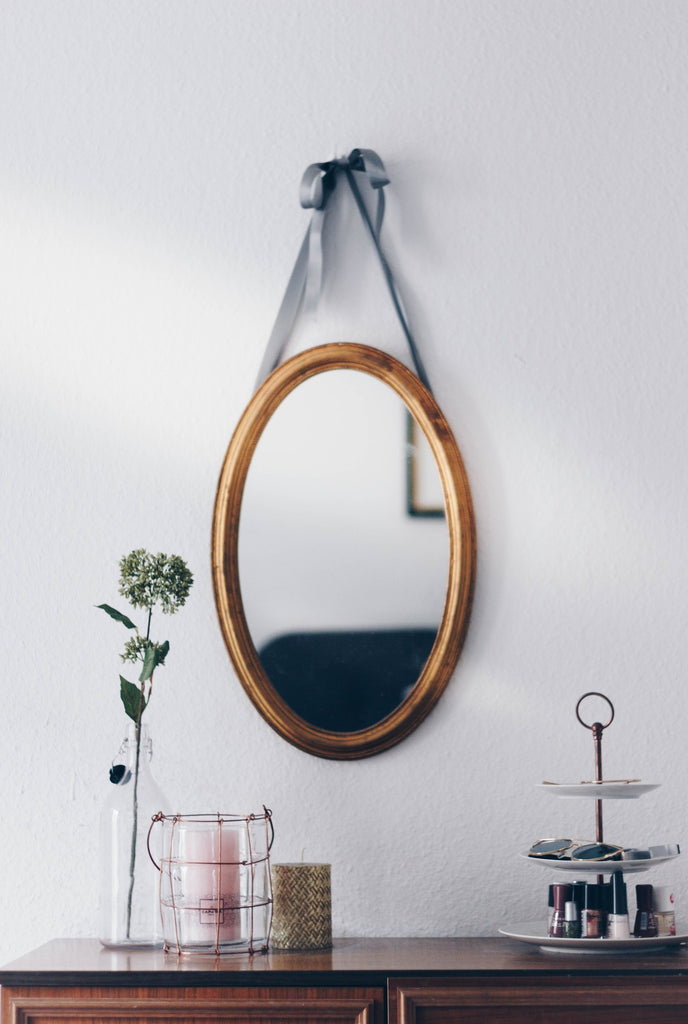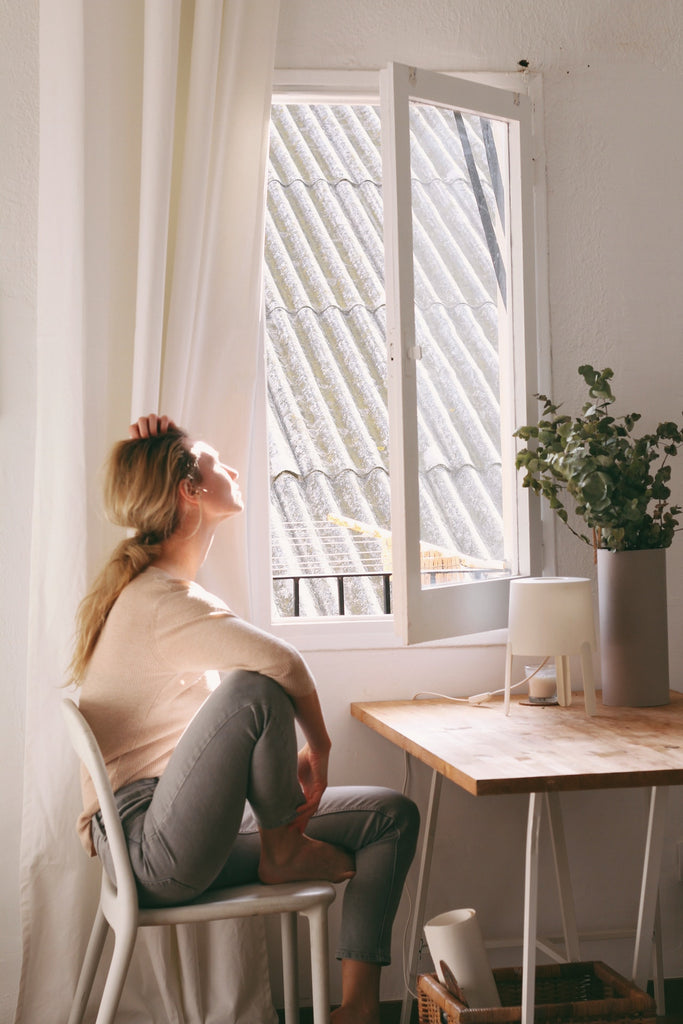It can be challenging to make a house feel like a home when your space lacks windows and natural light. But even the slightest glimmer and glow can transform a dark space into a warm and welcoming oasis. Read on for 15 ideas on how to fake natural light in a dark room.
15 ways to fake natural light
Below are 15 ways you can create the illusion of natural light in your home.
1. Use mirrors
Mirrors’ reflective properties can make your room feel larger and brighter. For example, let’s say your room has only one small window that lets in barely any light. In that case, you can place a mirror on the wall across from it to reflect light. You can even go the extra mile and fill your room with mirrored surfaces such as a mirrored coffee table or vanity. That’s just one great way to transform a dim room into a radiant sanctuary.

2. Utilize soft and warm hues
Warm lighting can transform any dark area into a comfortable, inviting space. Most warm lights are orange-yellow in color, a hue associated with restfulness and relaxation. They can add comfort to any unsettlingly dark space.
The BlissRadia is a great option for illuminating your dark space without adding any clutter. This lamp diffuses gentle hues that seamlessly transition from one color to the next. It can also shine in just one non-changing rainbow color. You can set it to mimic the sun’s rays through the BlissLights app too – the ultimate infusion of natural lighting in a dark room.


BlissRadia Smart LED Mood Light
$39.99
From desktop to bedside, light the way to concentration, stimulation, or relaxation.
3. Use neutral colors for furniture and walls
When painting and furnishing a room without windows, you want to keep your color scheme light and neutral. This is because darker tones absorb more light, so dark paint and furniture dull any illumination let into your space. Try pairing brighter paint colors with similarly hued furniture to set a more natural mood.

4. Add gloss to furniture surfaces
Faking natural light can be as simple as adding a fresh coat of white gloss to your walls, trims, ceilings, and hard furniture. That’s because glossy finishes are known to reflect more beams around the room, similar to mirrors. You can also invest in a few decor pieces that have a glossy or metallic finish, such as vases, jewelry holders, or metallic wall art. You’ll make your darkly colored space appear brighter and spark an enticing new energy.

5. Opt for light colors
If you’re dealing with a lack of natural light, you should avoid dark tones and designs. Yet while neutral colors are a great option, you don’t want to overload your space with white, tan, and gray tones. For a pop of color, try adding happy pastel hues. Robin’s egg blue, lavender, goldenrod, or a warm green can all create an astonishing warm glow.

6. Keep windows unobstructed from furniture
Maybe you like placing your bed frame or desk against a window for aesthetic purposes. In most rooms, that’s a great idea, but when you struggle with letting in the sun during the day, you should leave your windows as unobstructed as possible. This means you may have to compromise and move your furniture. You may also want to exchange your heavy curtains for sheer ones. If your windowsill still feels empty, try adding a plant in the corner to bring your space to life with the allure of nature.

7. Avoid clutter
In a dim room, clutter poses issues beyond taking up your space. Most clutter also lacks reflective properties – it’s not like glossy cabinets are part of your clutter – so it typically makes your home appear darker. One solution: Add furniture that doubles as storage space – especially bright-colored furniture. You can also decorate your walls with white floating shelves and dazzling trinkets that enliven the room from top to bottom.

8. Add subtle light fixtures
Maximizing the amount of light in your room means avoiding fixtures that become the center of attention. When a fixture acts as your focal point, it takes away from the actual light you’re adding to your space. Avoid obtrusive fixtures such as chandeliers and low-hanging pendants in favor of flush mounts. These types of fixtures can be like a mini-sun hanging overhead – they’ll bring a sense of daylight to your room while keeping things open and fresh.
9. Use sheer curtains
Although heavy curtains can be aesthetically pleasing, they won’t do your lighting situation any good. Instead, layer sheer curtains over blackout curtains to get the best of both worlds. This way, you can let in that tiny bit of available sun during the day. Then, when you go to sleep, you can pull the heavy curtains closed. A solid white sheer curtain can counter your space’s darkness, and turquoise or lavender sheer curtains can infuse your space with character.

10. Add floor lamps
Corners can look dark and eerie in a windowless room. That’s often because your overhead light doesn’t reach there, and that effect is stronger with no sun beaming into your space. A simple solution: a large floor lamp in the corner of your room. This tall lamp can transform any dark area into a soft, luminous sanctuary. It can also be a great decor piece that adds a whole new dimension to that strangely dark corner.
11. Place furniture near your light sources
Getting good light in a room with limited sun exposure can mean getting creative with everything else in the room. That includes your furniture, and some interior designers recommend keeping your couches and loveseats close to your lamps and other fixtures. This way, you’ll feel like you’re getting plenty of light no matter where you sit, even if no sunbeams reach through the windows. It’s a simple way to build a glowing world of your own.

12. Make any available windows a focal point
Even if you have a tiny window in your room, that means you do still get a bit of natural light. You should play that up as much as possible – you could make your window your room’s focal point. That’s because the more attention you draw to your light, the more significant it will seem. Arrange your furniture and decorations around this window and extend the whole scheme outward to make good lighting the star of your show.

13. Use recessed lighting
If you lack floor space in your living room, save yourself the clutter and brighten up your space with overhead lighting. When you’re low on natural light, though, one central source above your head won’t do the trick. You’ll need a bunch of recessed lights – the type where the bulbs go into and above your ceiling – for that luminous daytime shine. That can be all it takes to transform your small room with no natural light into a bright, inviting retreat.
14. Don’t get patterned lampshades
Bright, patterned lampshades might seem like a fun and unique option for a poorly lit room. After all, bright furniture and decor can elevate even the darkest of rooms. But in reality, colorful, patterned lampshades typically obscure the light they cover. Instead, choose lightly-colored lampshades that don’t block light. Pure white or eggshell lampshades can elevate your decor and add new depth to your surroundings.

15. Install under-cabinet lighting
In most cases, overhead lighting can’t fully illuminate a space on its own. You’ll need more fixtures for hard-to-reach areas such as countertops, bookshelves, or dresser drawers. Instead of using clunky fixtures that only add to your clutter, you can illuminate your less accessible spaces with LED strip under-cabinet lighting. For an easy setup, just peel off the adhesive backing and stick it right beneath any cabinet space.
Brighten up any dark space with BlissLights
With color-changing LED strips and ambient mood lights, you can transform any dark room into a glowing sanctuary. You can get both – and plenty of other DIY natural-light-faking options – through BlissLights. Browse the BlissLights collection now to see even your darkest spaces in a whole new way.You may also enjoy these...
Discover fun and unique lighting ideas on the BlissLights Lighting Blog!


















































